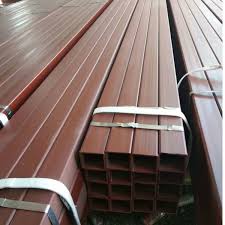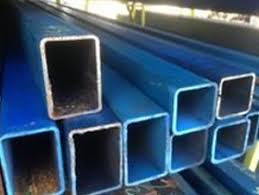Painted hollow steel features
Steel Grade
The choice of steel grade significantly influences the mechanical properties of a painted hollow steel section. Common grades include:

- Mild Steel (S235JR): Offers a good balance of strength and ductility, making it suitable for various applications.
- High-Strength Steel (S355JR): Provides higher yield strength and tensile strength, making it ideal for structures requiring greater load-bearing capacity.
- Weathering Steel (S355J2+N): Develops a protective rust layer over time, reducing the need for maintenance in certain environments.
Section Shape
The shape of the hollow section (e.g., rectangular, square, circular) affects its strength and stiffness.
- Rectangular: Offers good strength in both directions and is commonly used for structural applications.
- Square: Provides similar properties to rectangular sections but with a more compact shape.
- Circular: Offers maximum cross-sectional area for a given perimeter, making it ideal for applications requiring high torsional strength.
Painting Process
The painting process and the type of coating used significantly impact the section’s corrosion resistance, durability, and appearance.
- Powder Coating: A dry-powder coating that is electrostatically applied and cured in an oven. It offers excellent adhesion, durability, and environmental friendliness.
- Liquid Coating: A traditional method using liquid paints that are applied by spraying, dipping, or brushing. It provides flexibility in terms of coating thickness and finish.
Coating Types
The choice of coating type determines the section’s resistance to corrosion, weathering, and chemical attack. Common coating types include:
- Epoxy: Offers excellent corrosion resistance, durability, and chemical resistance. It is often used in harsh environments, such as industrial facilities and marine structures.
- Polyurethane: Provides good weather resistance, UV stability, and abrasion resistance. It is commonly used for exterior applications, such as building facades and fences.
- Acrylic: Offers good color retention, gloss, and flexibility. It is often used for decorative purposes, such as furniture and architectural elements.
Environmental Factors
Exposure to harsh environmental conditions can affect the performance of the coating and the underlying steel. Factors to consider include:
- Weathering: Exposure to rain, snow, and temperature fluctuations can accelerate corrosion.
- Chemical Exposure: Contact with corrosive substances can degrade the coating and the steel.
- Ultraviolet Radiation: UV rays can cause the coating to fade or degrade.
Additional Factors
Other factors that can influence the properties of painted hollow steel sections include:
- Welding: The quality of welding can affect the overall strength and integrity of the section.
- Fire Resistance: Certain coatings and fire-resistant treatments can be applied to improve the section’s fire resistance.
- Maintenance: Regular inspection and maintenance, such as cleaning and repainting, can help prolong the service life of the section.
Specific Applications
The choice of painted hollow steel section depends on the specific application and the required properties. Some common applications include:
- Structural Engineering: Building frames, bridges, towers, and other structures.
- Mechanical Engineering: Machinery components, such as frames, shafts, and tubes.
- Automotive Industry: Vehicle frames, chassis, and body panels.
- Industrial Equipment: Machinery components, such as pipes, ducts, and tanks.
- Architectural Applications: Building facades, railings, and decorative elements.

By carefully considering these factors, engineers and designers can select the appropriate painted hollow steel section for their specific applications, ensuring optimal performance and durability.
Price table
| Section Size | Type | Wall Thickness (mm) | Yield Strength (MPa) | Tensile Strength (MPa) | Elongation (%) | Price (USD/ton) |
|---|---|---|---|---|---|---|
| Small (50×50 mm) | Standard | 2.0 | 250 | 400 | 20 | 740 |
| Small (50×50 mm) | Premium | 2.5 | 275 | 450 | 22 | 770 |
| Medium (100×100 mm) | Standard | 3.0 | 250 | 400 | 18 | 760 |
| Medium (100×100 mm) | Premium | 3.5 | 300 | 460 | 20 | 790 |
| Large (150×150 mm) | Standard | 4.0 | 250 | 400 | 15 | 780 |
| Large (150×150 mm) | Premium | 4.5 | 320 | 470 | 18 | 810 |
| Extra Large (200×200 mm) | Standard | 5.0 | 250 | 400 | 12 | 800 |
| Extra Large (200×200 mm) | Premium | 6.0 | 350 | 500 | 15 | 880 |
Legend:
- Standard: Basic painted hollow sections with regular properties.
- Premium: Higher quality painted hollow sections with improved mechanical properties.
- Yield Strength (MPa): Stress at which the material begins to deform plastically.
- Tensile Strength (MPa): Maximum stress that the material can withstand.
- Elongation (%): The amount the material can stretch before breaking.